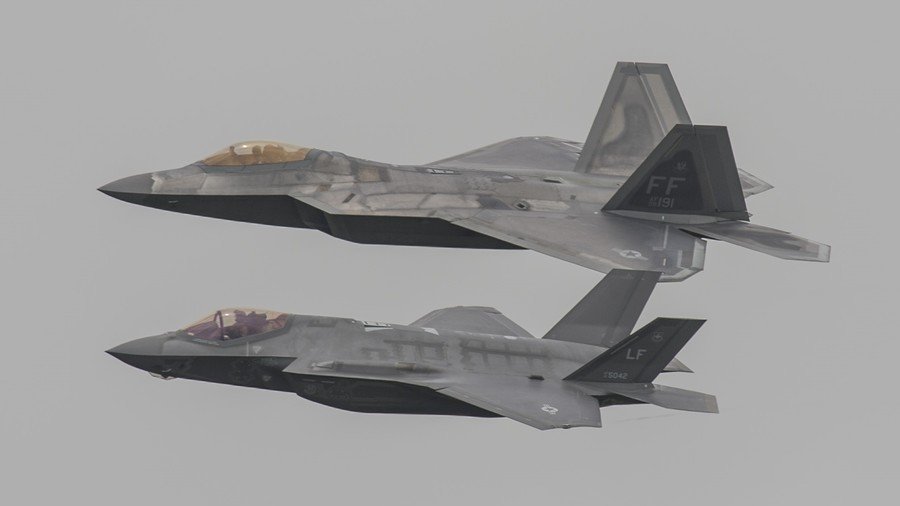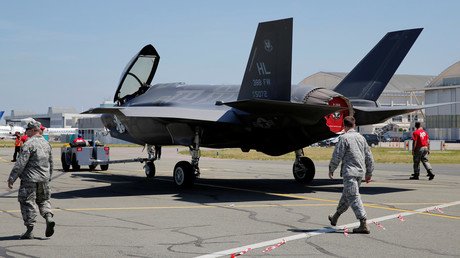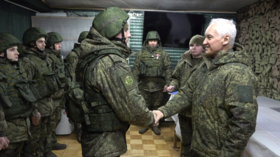2 bads make a good? US eyeing F-22/F-35 hybrid to counter ‘Russian & Chinese threats’ – report

The US is reportedly looking into a hybrid of two 5th generation fighter jets – the F-22 and F-35 – to help counter "Russian and Chinese threats." The two machines, both riddled with technical issues, might not mix well.
The hybrid was proposed to the US military by the arms giant Lockheed Martin, Defense One reported, citing sources "with direct knowledge of the plane." The plane is basically a modified F-22 Raptor with unspecified changes to its frame and featuring the modern avionics of the F-35 Lightning II.
Naturally, the plane is being sold as a powerful tool "to counter Russian and Chinese threats," according to the report. While the two are favorite scapegoats for the US military, especially when it pushes for more funding, it's unclear why exactly the US Air Force might need a new fifth-generation fighter jet to counter them. Moscow and Beijing have developed fifth-generation jets, yet both still lack any considerable fleets of such machines.
The F-22/F-35 hybrid plane is supposed to ensure the dominance of the US military while it's waiting for sixth-generation fighter jets, which are still years away. Earlier, the same idea of a hybrid jet was reportedly proposed to Japan. Tokyo has been seeking an upgrade to its fighter fleet for decades but has so far not procured any fifth-generation jets.
The exact specifications of the proposed hybrid plane remain a mystery. The operational history of the F-22 and F-35, however, raises doubts over whether mixing the two is actually a good idea.
The F-22, the very first fifth-generation fighter to ever enter service, is notorious for its extremely high costs, which eventually led to the shutdown of the program in the early 2010s. The US Air Force initially envisioned ordering 750 Raptors, but the growing price tag of the program meant that only some 200 machines were built and procured. The flyaway cost of one unit in 2009 was $150 million, yet, taking into consideration the research and development costs, a single F-22 plane amounted to a whopping $400 million.
Raptors were riddled with a number of critical issues, namely problems with the oxygen-supply system and the Low Observable (aka 'stealth') coating. The coating proved to be quite weak, susceptible to wear and tear, as well as weather, as it basically got washed away. The problem with coating still persists, according to a recent report by the US Government Accountability Office (GAO). The stealth coat requires time-consuming and complicated maintenance, which often grounds the jets. Spare parts for the planes are also not readily available, the report states, therefore the US fleet of F-22s suffers from "reduced and unpredictable aircraft availability."
The F-22/F-35 hybrid will feature "advancements in the stealth coatings and things of that nature," according to Defense One, though no exact details have been provided. The F-35 aircraft development program repeatedly missed deadlines, while the costs of each unit continues to grow, now estimated to surpass $120 million. Despite their lengthy development, the jets are still riddled with numerous issues, including with the coating, which might "melt" during a flight at supersonic speed, according to another report by the GAO, released in June.
The report named almost 1,000 various technical issues affecting the F-35 jets, including 111 designated as Category 1 flaws, which "may cause death, severe injury, or severe occupational illness; may cause loss or major damage to a weapon system; critically restricts the combat readiness capabilities of the using organization; or result in a production line stoppage," according to the US military definition.
A new report by another watchdog, Project On Government Oversight (POGO), has found that the F-35 program is actually cutting corners to call the development "complete" instead of actually fixing the issues. Namely, a number of Category I problems were simply downgraded to a less serious Category II, which could "impede or constrain successful mission accomplishment."
Like this story? Share it with a friend!
















